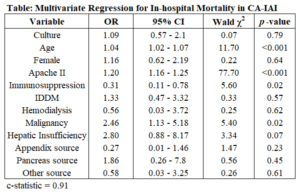Obtaining Cultures in Community-Acquired Intra-Abdominal Infection is not Associated with Outcome
Author(s):
Zachary Dietch; Nathan Elwood; Elizabeth Krebs; Taryn Hassinger; Kimberly Ann Popovsky; Traci Hedrick; Robert Sawyer
Background:
Most patients with community-acquired intra-abdominal infection (CA-IAI) are successfully managed with source control and empiric antimicrobial therapy. As a result, clinical guidelines do not recommend routine collection of cultures, despite an absence of rigorous data to support this recommendation. With the rise of antimicrobial resistance, this recommendation warrants further scrutiny.
Hypothesis:
We hypothesized that obtaining cultures is not an independent predictor of death in the management of CA-IAI.
Methods:
All surgical patients with CA-IAI admitted to an academic institution between 1996 and 2011 were included. Univariate analyses compared characteristics and outcomes between patients with cultures and those without. Multivariable logistic regression evaluated the independent effect of obtaining cultures on in-hospital mortality, while controlling for other factors.
Results:
A total of 1,192 patients with CA-IAI were included for study and cultures were obtained in 621 (52.1%) patients. Patients with culture data had higher median APACHE II scores (10 vs. 9, p<0.001), higher rates of malignancy (11.3% vs. 7.4%, p=0.03), insulin-dependent diabetes (11.1% vs. 7.4%, p=0.03), and select comorbidities included in multivariate analysis. Culture data was more frequently obtained in patients with a pancreatic source of CA-IAI (4.3% vs. 1.8%, p=0.02) and less frequently obtained when infection originated from the appendix (13.0% vs. 20.3%, p<0.001). In patients with cultures; mixed flora (27.1%), Streptococcus spp. (18.9%), Escherichia coli (15.1%), and Candida albicans (11.1%) were the most commonly speciated organisms. Unadjusted mortality was higher among patients with cultures although this relationship did not reach significance (6.0% vs. 4.0%, p=0.16). On multivariate regression, obtaining cultures was not associated with mortality (Table). Obtaining cultures was associated with a longer median duration of antibiotic therapy (11 vs. 9 days, p<0.001) and median hospital stay (7 vs. 5 days, p<0.001).

Conclusions:
We did not identify a relationship between the acquisition of cultures in CA-IAI and survival, and obtaining cultures was associated with a longer duration of therapy and hospital length of stay. These data support current guidelines that cultures do not yield benefit in the management of CA-IAI.

